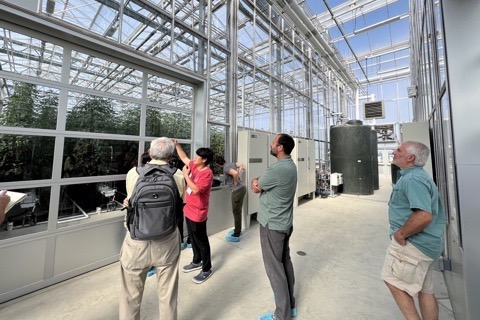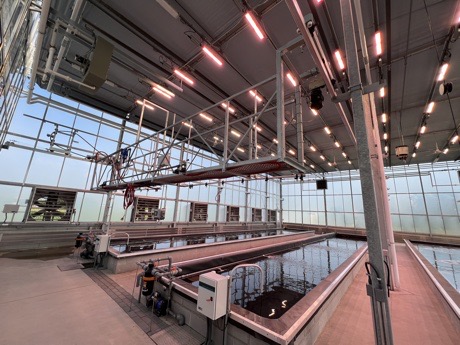7/26/2023
A Tour of the OHCEAC
Jennifer Polanz
Photography by Jennifer Polanz
 This year, I was able to attend in person the 2nd Annual CEA Conference hosted at the new OHCEAC (Ohio Controlled Environment Agriculture Center) on The Ohio State University campus. The brand new facility has multiple greenhouse bays, labs and testing locations for a variety of research, and after the day-long workshop we got the grand tour.
This year, I was able to attend in person the 2nd Annual CEA Conference hosted at the new OHCEAC (Ohio Controlled Environment Agriculture Center) on The Ohio State University campus. The brand new facility has multiple greenhouse bays, labs and testing locations for a variety of research, and after the day-long workshop we got the grand tour.
In the two 5,000 sq. ft. high-wire greenhouse bays, the construction included single-layer diffuse glass for the side walls and state-of-the-art ETFE (ethylene tetrafluoroethylene) plastic film for the roof, which is lighter and more transparent than glass, hail-proof and requires less steel framing to support it. It also has supplemental LED lighting, air circulation fans with a fogging system and a smart shade screen. The goal was to mimic the most advanced greenhouse operations today. They can grow tomatoes, cucumbers, peppers and more in there.
A third 5,000-sq. ft. bay will be dedicated to strawberry research and the fourth 5,000-sq. ft bay features permanent hydroponic ponds for Deep Water Culture (DWC)-based research (pictured below). Currently, there’s one high-wire bay planted with tomatoes, with a second one coming to research-advanced growing through automation and climate sensors.
 What’s also impressive is the nutrient and irrigation system, which is a 12-head injector housed in one room that’s pumped to the different greenhouse bays. For example, each of the four pools for DWC research can be served different nutrient solutions and the tomato greenhouses can be served one of two nutrient mixes. Large tanks outside the tomato greenhouses allow them to recirculate water by filtering it and sterilizing via a UV treatment.
What’s also impressive is the nutrient and irrigation system, which is a 12-head injector housed in one room that’s pumped to the different greenhouse bays. For example, each of the four pools for DWC research can be served different nutrient solutions and the tomato greenhouses can be served one of two nutrient mixes. Large tanks outside the tomato greenhouses allow them to recirculate water by filtering it and sterilizing via a UV treatment.
In the DWC bay, there are ceiling fans designed to create a downward current to prevent tip burn, and each of the ponds has water-level sensors monitoring EC, pH and dissolved oxygen (DO).
In another section of the facility, there are more bays for floriculture and lettuce research. There’s also a wet lab for analysis and additional research.
You can visit the OHCEAC website to find out more about the research being conducted at the facility.